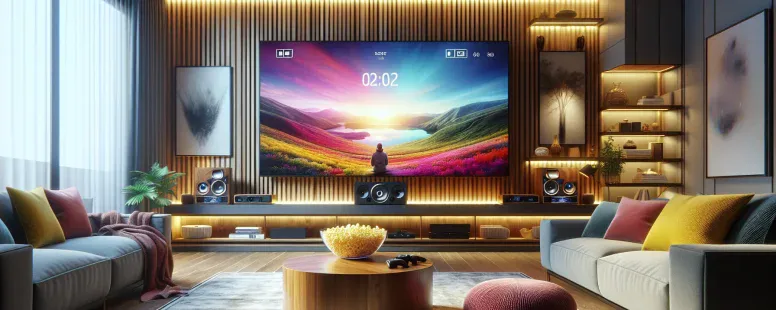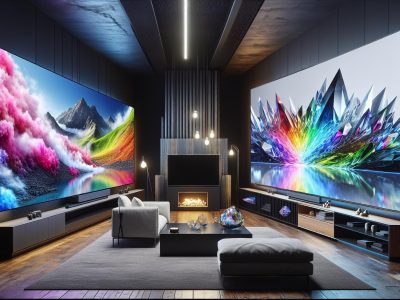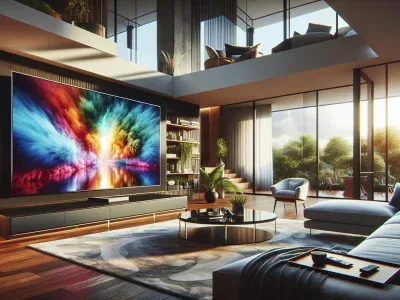Difference Between UHD and QLED: Which TV Technology is Right for You?
Picture yourself sinking into your couch as the screen before you bursts to life—colors so vivid they almost leap out, every detail razor-sharp. But when you’re choosing a new TV, terms like UHD and QLED swirl around like confetti, each promising a viewing experience that’ll transform your nights in. What really sets these two apart, and which one will make your favorite movies and games truly pop?
You might think it’s just about pixels or price, but there’s more beneath the surface. The secret lies in how each technology brings images to life, offering surprising perks that go beyond resolution. Whether you crave cinematic brilliance or crave deeper blacks and dazzling brightness, understanding the real difference could change the way you see everything. Ready to uncover which screen will steal the show in your living room?
Understanding UHD and QLED Technologies
Pixels spark—colors burst—your screen glows. As your eyes scan a UHD or QLED display, wonder brews: what’s inside these rectangles of light that makes reality seem just an inch away? UHD and QLED deliver visual magic with two very different tricks—let’s look at how their core elements set the stage for cinema right in your living room.
What Is UHD?
UHD, or Ultra High Definition, refers to a display resolution of 3840 x 2160 pixels, quadrupling full HD’s pixel count. Picture standing in a city that spreads four times farther than your old hometown—you’d spot details you never seen before. On a UHD TV, every blade of grass in a soccer match or bead of sweat on an actor’s face jumps out. Broadcasters like Netflix, Disney+, and Amazon Prime Video stream movies and TV in UHD formats, giving you access to original sharpness as directors intend (source: Netflix tech specs 2023).
Manufacturers—Samsung, LG, Sony, and TCL, for example—build UHD into both entry-level and premium displays, opening access to high-res content for wide audiences. UHD lacks a specific display panel technology: you’ll find it in LCDs, OLEDs, QLEDs, and more, directly connecting UHD with clarity regardless of lighting or color tech involved.
What Is QLED?
QLED, or Quantum Dot Light Emitting Diode, is not a resolution—it’s a panel technology pioneered by Samsung and now licensed by TCL, Hisense, and Vizio. Instead of changing the number of pixels, QLED changes how each pixel shines. Quantum dots—nanocrystals smaller than a virus—filter light to produce dazzling reds, greens, and blues (source: Samsung Display Newsroom, 2022).
Picture a painter’s palette except every color glows like precious stones under a spotlight. The quantum dots in QLED panels make that real: they boost brightness, resist burn-in, and deliver rich, dramatic colors even in sunlit rooms. QLED TVs always support high resolutions like UHD, but their special power lies in adding volume to the colors—reds that sizzle, blues that pulse, greens sharper than reality.
If you’ve ever compared TVs in a bright store aisle, QLED’s vivid hues and punchy whites leap at your eyes. Critics love QLED for sports and animated movies because it keeps colors true even at maximum brightness (source: RTINGS reviews 2024).
So, does UHD make details clearer while QLED makes them brighter and bolder? What matters more, crisp digital sharpness or a living-room sunset that looks just like the real sky—only more intense? These two techs may cross paths, but their journeys to visual mastery are anything but the same.
Key Differences Between UHD and QLED
UHD and QLED change how you see TV: one affects pixel count, the other transforms how colors glow on your screen. They combine but never replace each other—each delivering a unique viewing advantage.
Display Technology Comparison
UHD refers to the screen’s resolution, using over 8 million pixels (3840 x 2160). It’s a standard across most TV brands, including LG and Hisense. QLED describes a specific panel technology, pioneered by Samsung, that adds a layer of quantum dots in front of an LED backlight. These quantum dots emit pure colors when hit by light. For example, you’ll notice QLED’s visual edge during fast-paced video games with bright, contrasting visuals. UHD tells you how many pixels you have for detail, while QLED tells you how those pixels create color and brightness.
Picture Quality and Color Performance
QLED TVs achieves higher brightness levels (sometimes over 2,000 nits), which is ideal for rooms with natural sunlight or reflections. Quantum dots offer richer colors, with more saturation in reds and greens, compared to conventional LED TVs. UHD doesn’t guarantee better color—even a UHD screen with basic LED technology can look washed out if the panel is low-grade. Independent reviews from RTINGS and Consumer Reports regularly highlight QLED’s vibrant output in HDR movies, sports, and animated features. If you love vivid animated films or high-energy sports, QLED demonstrates a visible difference in how colors “pop.”
Resolution and Clarity
UHD boosts clarity, bringing out details like the individual feathers on an eagle or subtle facial expressions in a crowd scene. Every UHD TV—regardless of whether it’s QLED, OLED, or LED—displays 3840 x 2160 pixels every frame. Streamers and gamers benefit from UHD during high-action sequences since edges look smoother compared to Full HD or HD Ready panels. But, pixel count isn’t always everything: a mid-range UHD panel without advanced color or contrast enhancements may look flat next to a QLED model, even though both have identical resolutions. Test patterns from calibration tools like Spears & Munsil demonstrates the detail UHD enables, but QLED’s color layer will enhance that detail with richer tonal depth.
Choosing the Right TV: UHD vs QLED
You’re standing in an electronics store, a wall of TVs winking for your attention, each promising the sharpest, brightest, most spellbinding picture. UHD and QLED—words tossed around by salespeople—start to sound like cryptic codes. But what matters for your living room binge nights or game-day parties?
Factors to Consider
Display technology sits at the heart of the UHD vs QLED debate. UHD means Ultra High Definition, which gives you four million more pixels than HD, so every wrinkle on a movie star’s face pops with clarity. QLED, though, uses Quantum Dots to squeeze out extra color and brightness—picture fireworks on the Fourth of July, every spark sizzling with intensity. Which is better? Your viewing habits say a lot. If you stream 4K documentaries about wild arctic foxes or watch fast-paced soccer games, QLED’s higher brightness and vivid colors (especially in HDR content) leads to richer, more dynamic scenes. On the other hand, UHD’s raw detail shines during drama shows or cinematic marathons, especially in dim rooms where subtle shades can be appreciated.
Lighting conditions in your space can tilt the scales. For rooms flooded in sunlight, QLED’s superior peak brightness and anti-reflective coatings make a noticeable difference—colors won’t wash out like watercolors in rain. If your den stays dark, UHD’s clarity may suffice, as glare isn’t really an issue. Sometimes, factors outside specs matter most. How big is your wall? Is 65 inches too much, or do you want a screen that stretches dreams across the room? Native UHD resolution covers nearly all mid- to large-sized TVs, but QLED models dominate premium shelves, often bundled with better motion handling and gamer-friendly refresh rates (up to 120Hz in recent models; CNET, 2023).
Price and Availability
Budget frequently shapes your decision more than specs. UHD sets usually cost less, making them accessible for first-time buyers or those upgrading from aging HD models. In 2023, basic UHD TVs from brands like TCL or Hisense hovered around $400 for 55-inch screens, while entry QLEDs start closer to $600 for similar sizes (TechRadar, 2023). Availability, too, fluctuates—UHD TVs appear in more stores and brands, while QLED options, pioneered by Samsung but now sold by TCL and Hisense, still cater to color aficionados with deeper pockets.
Sales cycles add complexity. During Black Friday, doorbuster UHD models push prices down even further, sometimes undercutting QLED by hundreds of dollars. Yet, those premium QLEDs, with Dolby Vision and advanced upscaling, often grab the spotlight during new model launches.
Some folks chase the newest tech, others snag deals when older models drop in price. Both UHD and QLED get regular updates, with 2024 models promising sleeker designs and smarter processors. In the end, the right TV feels less like deciphering a spec sheet, and more about finding a window that fits your world—whether that’s cinematic detail, dazzling colors, or simply the best bargain lighting up your wall.
Real-World Performance and Use Cases
You notice right away the difference between UHD and QLED the moment you sit infront of them. UHD brings every scene crisply to life, especially if you’re watching nature documentaries on platforms like Netflix—think tiny dewdrops on leaves or intricate animal fur details. QLED, on the other hand, turns a sporting event into a festival of colors. Picture the electric blues and bright greens of a World Cup match; QLED’s quantum dots push those hues past what standard UHD panels can muster.
Let’s suppose you mostly watching in a sunlit living room. QLED is engineered—according to Samsung’s own product claims (Samsung Newsroom, 2022)—to enhance screen brightness, reducing glare and keeping colors from fading. UHD might struggle here, especially with reflected sunlight dulling the picture’s impact. Kids watching animated films like Pixar’s “Soul” or “Turning Red” will find QLED’s color range might makes every scene pop, while UHD could feel flatter unless paired with premium panels.
Gamers won’t want to miss the faster refresh rates and improved brightness QLED offers, especially if you plug in next-gen consoles like PlayStation 5. Fast-paced scenes in “Gran Turismo 7” look fluid and punchy on QLED displays, while a basic UHD TV maybe not keep up with the rapid motion. Yet if you stream most shows in the evening, a budget UHD set can deliver a cinematic experience, especially with 4K content where resolution has top priority.
If you ask friends about their TV preferences, answers cover more than just specs. Some swear by UHD for classic film nights—grainy textures in “Casablanca” appear truer. Others crave the eye-popping spectacle QLED delivers during awards shows or music festivals. Retailers often display both side by side, daring your eyes to pick a favorite, but seeing isn’t always believing. Lighting, source content, and even your seating angle can all switch the advantage from one display to another.
Afterall, UHD and QLED thrive in specific usage scenarios: UHD excels if detail, budget, or compatibility with broad content libraries matter most, while QLED’s strengths emerge in bright rooms, colorful content, and lively viewing situations. In 2023, more than 55% of large-panel TVs sold globally supported UHD, but only about 13% used QLED technology (Omdia, 2024). Choosing between them, you weigh bright spectacle against sharp detail—each fitting a distinct user profile and environment.
Conclusion
When you’re shopping for a new TV it’s easy to get overwhelmed by all the technical terms. Understanding the true difference between UHD and QLED helps you find the best fit for your lifestyle and viewing preferences. Whether you want crisp detail for movie nights or vibrant colors for daytime sports there’s a display that matches your needs.
Take a moment to consider how and where you’ll use your TV. With this knowledge you’ll feel more confident making a choice that brings your favorite shows and movies to life.
- GDP Versus GNP: Understanding the Key Differences - November 14, 2025
- Which Is Best: CV or Resume? Understanding the Differences - November 14, 2025
- Which Is Best: ECE or CSE? - November 14, 2025







